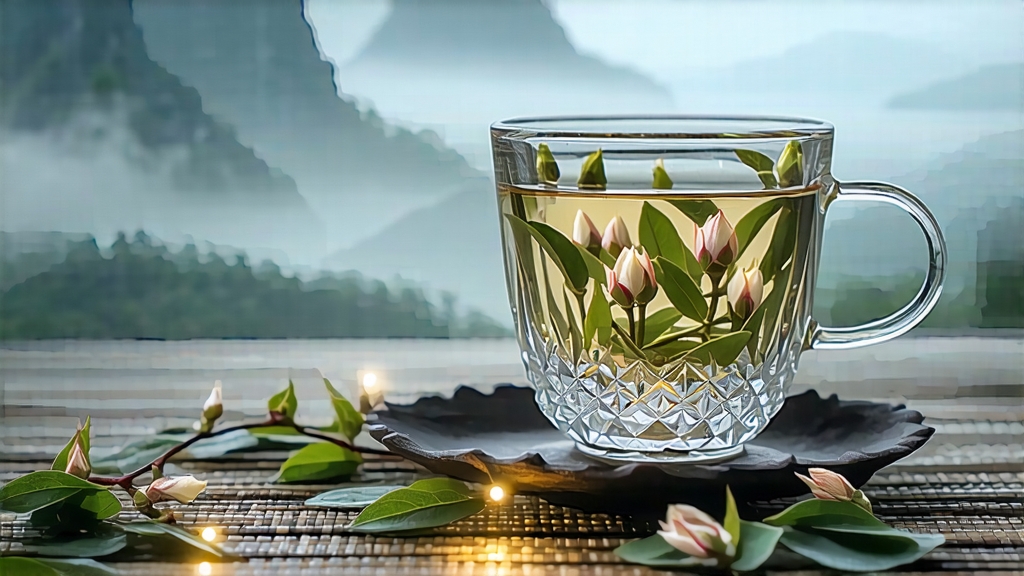
Among the six great families of Chinese tea, white tea is the least theatrical: no rolling, no roasting, no fierce charcoal fires—only time, air, and the patience of Fujian’s cool dawns. Within this minimalist lineage, Fuding Silver Needle (Bai Hao Yin Zhen) sits at the apex, a bundle of down-clad buds that look more like poetry than agriculture. To understand China’s most delicate tea, one must listen to stories carried on sea breezes from the East China Sea, walk the red-soil hills of northern Fujian, and learn to taste silence.
Historical whispers place the birth of white tea in the late Song dynasty, but Silver Needle’s documented fame begins during the Qing Qianlong era (1735-1796). Imperial tribute lists from Fujian report “silver-tip buds, three thousand liang yearly,” wrapped in silk and escorted north by fast horses. Foreign merchants first encountered it in 1850s Fuzhou docks, where downy needles were packed into lead-lined chests for London auction rooms marketed as “Pekoe Souchong Imperial.” The name confused Europeans—Pekoe originally referred to Indian leaf grades—yet the visual drama of pure buds quickly created a luxury niche. By 1890, Silver Needle fetched six times the price of black Keemun, becoming one of China’s earliest export status symbols.
Geography is destiny. Authentic Silver Needle comes only from two counties: Fuding and Zhenghe, separated by a ridge of weathered granite. Fuding’s terroir—low hills of acidic lateritic soil, 600-800 m elevation, 1600 mm marine rainfall, and nightly sea fog—forces the tea bush (predominantly Fuding Da Bai Hao cultivar) to grow slowly, thickening the protective down on each embryonic leaf. The down is trichomes: tiny hairs rich in amino acids that later translate into the tea’s signature velvety sweetness. Zhenghe versions, harvested later and from Xiao Bai cultivars, carry darker liquor and stronger tannic spine, but connoisseurs prize Fuding for its lilac-water clarity and marine-mineral finish.
Plucking rules are strict: only the unopened bud, plucked before Qingming (early April) when its length reaches 2.5–3 cm. Experienced pickers work barefoot to avoid bruising bushes, snapping the bud with thumbnail rather than twisting. A full day’s harvest by a skilled woman weighs barely 500 g fresh; 30,000 buds shrink to 100 g after drying. Such ratios explain cost, but also explain reverence: every cup represents a hand-counted constellation.
Processing is disarmingly simple, yet unforgiving. The fresh basket is first spread on bamboo trays under morning shade for “soft withering,” reducing moisture from 75 % to 55 % over 4-6 h while enzymes begin gentle oxidation. Around noon the trays move into a sun-warmed corridor with latticed walls; indirect light and mountain breeze continue withering for 24-36 h. Nighttime humidity is critical—too much and the buds sour, too little and they brittle. Master tea makers judge readiness by sound: a bud flicked between fingers should sigh, not snap. Finally, the semi-dry needles rest in a low-temperature oven (40 °C) for 30 min to fix residual moisture at 5 %. No kneading, no shaping—the bud keeps its natural arrow form, silver against sepia like calligraphy brushed on rice paper.
Chemistry mirrors craft. Minimal heat preserves L-theanine (up to 4 % of dry weight), creating brothy umami, while a slow 8-12 % oxidation converts catechins into delicate theaflavins, explaining the pale apricot hue. Volatile aromatics—linalool, geraniol, cis-jasmone—remain intact, giving cool cup notes of honeydew, cucumber skin, and faint marine iodine. Over years, residual enzymes continue micro-oxidation; aged Silver Needle (bai cha yue chen) develops date, sandalwood, and medicinal depth prized by Guangdong collectors who cellar it like Burgundy.
To brew Silver Needle is to practice tea ceremony without theatrics. Begin with still mineral water (TDS 50-80 ppm); hard water dulls the downy texture. Pre-warm a tall glass gaiwan (120 ml) so rising steam rinses the lid. Weigh 4 g of needles—about